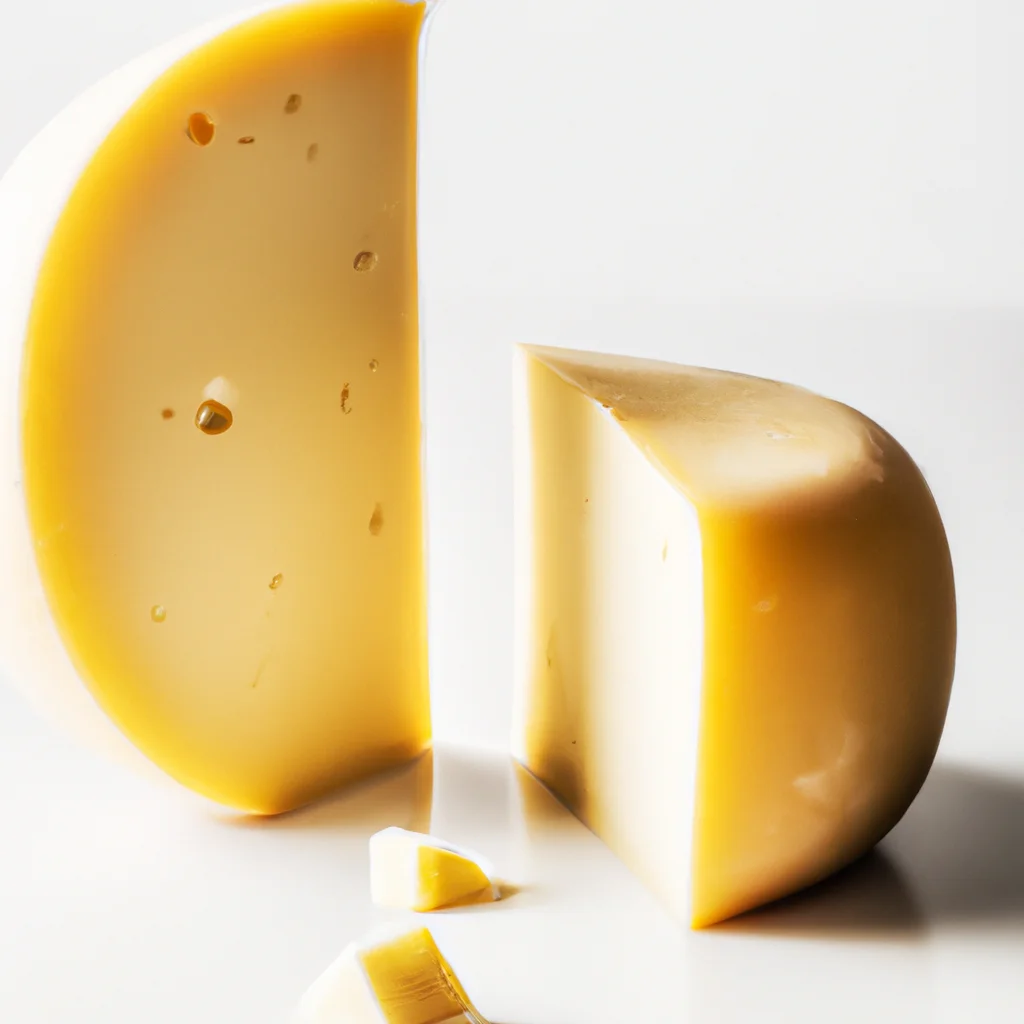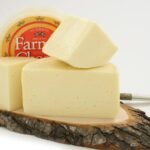Hailing from the fertile green pastures and gentle hill slopes of Denmark, Esrom cheese, also known as Danish Port Salut, has a long standing tradition etched into Denmark’s cheese-making history. This delicately nuanced delight is a semi-soft, interior-ripened cheese that carries a full and rich but mild flavor, and a unique past that makes it more than just dairy product. Esrom cheese belongs to the Trappist monastery cheese family, named after the Esrom Monastery where it was first produced in the 12th century. While the original manufacture dwindled over time, the recipe was rediscovered and revived in the 20th century, ensuring that this cheese continues to play a seminal role in Denmark’s gastronomic tapestry.
Often appreciated for its distinctive pungent aroma, Esrom cheese is made from partially skimmed cow’s milk and ripened for between 10 days to 2 weeks. Underneath its orange-yellow, mold speckled rind, the cheese manifests a supple and slightly elastic texture, with a small scattering of holes. As the cheese ages, it develops stronger flavors and assumes a more robust character, with the rind growing heavier and the taste becoming more pronounced. Its creamy, slightly bitter yet sweetly aromatic flavor profile reminds many of a nutty undertone, with hints of earthy and peppery notes.
Pair Esrom cheese with dark rye bread, fresh fruits, or light-bodied wines like Beaujolais to bring out its elegant and subtle flavor. Whether it’s served alongside evening cocktails or featured as the star in your gourmet dishes, the Esrom cheese, with its unique blend of richness and rustic simplicity, will certainly add an intriguing dimension to your tasting experience.
With an impressive tradition and an unapologetically pungent flavor, this artisanal Danish cheese is certainly worth exploring for every culinary enthusiast. So the next time you are in the cheese aisle, compel your adventurous spirit and pick the Esrom cheese. It’s not just cheese, it’s Denmark’s glorious cheese-making heritage wrapped in a flavorful bite.
Welcome to our quiz on the topic of Esrom cheese from Denmark! This distinctive cheese has a rich history and a flavor to match. Do you think you know all about it? Let’s put your knowledge to the test!

The Craft and Unmistakable Quality of Esrom Cheese from Denmark
The noble art of cheesemaking takes many forms and presents many delights, and one of the finest exemplars of this tradition is Esrom cheese. This semi-soft, slightly creamy, Trappist-style cheese hails from the humble shores of Denmark and boasts a rich history that only serves to enhance its remarkable flavour profile. Esrom, named after the Esrom Abbey where it was first produced by monks in the 12th century, is now an irreplaceable member of the exclusive club of high quality, Protected Designation of Origin (PDO) cheeses.
If you’re a connoisseur of good cheese, distinguishing Esrom is an experience that engages the senses. Visually speaking, an authentic wheel of Esrom cheese possesses a distinctive mottled, washed-rind exterior ranging in color from pale yellow to deep orange. Inside, the pate presents a light yellow hue with irregular sized holes dotting the texture. But the beauty of Esrom cheese truly lies in its odour and taste profiles. Despite its outwardly mild appearance, Esrom emits a robust aroma — a pleasantly earthy, slightly pungent smell — that prepares you for the depth of flavour to come. The overall taste experience of Esrom cheese is layered and rich, offering a wonderful balance of sweet, tangy, savory, and nutty notes with a decidedly bold ‘tang’ and a lingering aftertaste.
Quality properties in Esrom cheese are deeply influenced by its traditional processing. It is made from cow’s milk that is partially skimmed and heated then laced with cultures and rennet. This mixture is left to coagulate, after which the curds are cut, stirred gently, drained, and later transferred to moulds. But what truly sets Esrom apart is its maturation process. The wheels of cheese are regularly washed, turned, and brushed in a heat and moisture-controlled environment, traditionally for about 10-13 weeks. This process induces the cheese to develop its peculiar, potent aroma and distinct intense flavor, making it a worthy addition to any gourmet cheese plate.
The Esrom cheese is not just a feast for the palate but also a reflection of the rich cheese-making tradition that continues to flourish in Denmark. With each bite, you savour the grandeur of its history, depth of its taste, and the careful craftsmanship that goes into its production. So the next time you’re seeking an unforgettable cheese experience, keep an eye out for this exceptional Danish delight.
Discover the Esrom: Denmark’s Flavorful Semisoft Cheese
Originating from Denmark, Esrom, also known as Danish Port Salut, is a delectable, Trappist-style cheese that has been loved by food enthusiasts worldwide for its unique combination of flavorful features. Named after the Esrom Abbey where it was first crafted by Cistercian monks in the 12th century, this cheese carries a rich and savory history just as enticing as its flavor and texture.
Esrom is a semi-soft, cow’s milk cheese. The rind is typically orange-brown and has been washed in a brine solution – a cheese-loving process that enhances flavor and gives a subtle pungency. Inside, the paste of the cheese presents a small hole structure with a creamy to pale yellow color. When young, Esrom is mildly aromatic and its flavor is rich, sweet, and full-bodied. However, as it ages, the cheese develops stronger, robust flavors and a more pungent aroma, with characteristics likened to the deeply appreciated Reblochon or Livarot cheeses.

An essential factor that adds to Esrom’s charm is its nutritional value. This Danish cheese is rich in protein and calcium, providing a healthy dose of essential nutrients. Moreover, the cheese gluten-free and has a relatively low fat content, making it a fabulous choice for health-conscious cheese aficionados:
- Protein: 25 grams per 100 grams
- Calcium: 800 milligrams per 100 grams
- Fat: 28 grams per 100 grams
In terms of its application in the culinary world, Esrom plays a versatile role. It serves excellently on cheese platters, sandwiches, and burgers owing to its melting characteristic. When paired with dark beers or red wines, the nuances of Esrom come alive, offering a sensation that delights the palate. Conclusively, from avid cheese lovers to food experimenters, the Esrom surely promises a journey of rich Danish gastronomy to all.
- The name ‘Esrom’ originates from the Esrom Monastery in Denmark.
- Over time, the production of Esrom cheese shifted from the monastery to commercial dairies.
- The cheese is historically linked with the Cistercian monks who lived in the Esrom Abbey in the 12th century.
- Esrom cheese is also known as Danish Port Salut, a name borrowed from a type of French cheese.
- The cheese itself has a full-bodied, intensive flavor and is classified as semi-soft.
- In addition to its rich taste, Esrom cheese is notable for its pungent aroma, particularly when aged.
- Esrom cheese pairs well with crusty bread and robust wines, making it a favorite among cheese lovers.
The Authentic Taste of Denmark: A Journey into the Production of Esrom Cheese
Denmark, a country recognized for its rich culinary heritage, has made significant contributions to the world of cheese, with Esrom topping the list as one of its most prized productions. Named after the town of Esrom, this Danish cheese continues to garner praise for its unique texture, flavor, and production process that pays homage to traditional cheese-making techniques.
Esrom cheese, which is also known in some quarters as Danish Port Salut, is a semi-soft, interior-ripened cheese that traces its roots back to the Esrom Monastery’s humble cheese-making tradition in the 12th century. Over the years, Esrom cheese has become more than a mere staple in Danish households, evolving into a symbol of Denmark’s commitment to high-quality cheese production. It has a slightly pungent aroma, a full-bodied flavor, and is characterized by small holes scattered throughout a springy, creamy texture. Its piquant, slightly bitter taste, and creamy texture are the direct results of the unique cheese-making process, a testament to the high-quality milk used and the cheese-makers’ dedication.
Producing Esrom cheese begins in the lush, fertile countryside of Denmark, where dairy herds thrive on natural pastures. This environment allows the cows to produce high-quality milk imbued with the freshness of the Danish pastures, serving as the fundamental ingredient of Esrom cheese. After collecting the milk, cheese-makers add bacterial cultures and rennet, triggering the process of curdling. The curd is then cut, stirred, and eventually pressed into molds. The shaped cheese is subsequently aged in controlled conditions, fostering the development of its distinctive flavor and aroma. Remarkably, an extended aging period results in a more pronounced flavor profile.
- The production process strictly adheres to geographical indications, signifying the importance of region in shaping the cheese’s overall character.
- The region’s unique environmental conditions and aging process contribute to its distinctive flavor and aroma.
- Esrom cheese is a PGI (Protected Geographical Indication) product, ensuring that at least one production stage takes place in the origin’s geographical area, maintaining the integrity of the product.
With a commitment to exceptional quality production and maintaining traditional cheese-making practices, Esrom cheese embodies the quintessence of natural and culinary wealth Denmark has to offer.
Unlocking the Savory Delights of Esrom – Denmark’s Hidden Cheese Gem
The art of cheese connoisseurship is a realm of endless discovery, marked by the vibrant flavors and diverse textures that are unique to every region. Of these, Esrom cheese, hailing from Denmark, is a must-try crowd pleaser. It is an exquisite Danish cheese named after the monastery where it was first crafted, the Esrom Monastery. Its tasty dimensions unfold in many ways to those who admire its complex yet balanced flavor profile. The ultimate Esrom experience is best enjoyed with a few simple but savvy strategies.
Esrom, or ‘Danish Port Salut’ as it is sometimes called, possesses a soft, slightly elastic texture that’s perfect for melting. It’s characterized by its aromatic, pungent aroma that’s reminiscent of the Trappist style of cheeses, which only deepens as it ages. Its distinctive, semi-hard style and washed-rind are matured for a period of at least 10 to 12 weeks, achieving a pale yellow color and small, irregular holes that are a testimony to its carefully controlled fermentation process. This cheese carries a full flavor that blends a touch of sweetness, a hint of nuttiness, and a dash of tang, delivering an intricate balance that’s truly a delight to the palate.
To enjoy Esrom at its best, it should be served at room temperature to allow all its nuanced flavors to come alive. Its creamy consistency and rich flavor make it a versatile cheese – it’s perfect as a table cheese to be savored on its own, as a melting cheese to enhance a variety of dishes, or as an exciting feature on a cheese board, paired with a well-aged, fruity red wine to offset its strong aroma. Including the following treats on your cheese board with Esrom can create a lovely tasting experience:
- Figs: Their natural sweetness pairs exceptionally well with the deep flavors of Esrom.
- Almonds: These provide a contrasting crunchy texture that complements the creaminess of Esrom.
- Dark Rye Bread: A traditional Danish choice that balances the cheese’s pungency.
Whether you embark on a Danish-themed food adventure or wish to spruce up your culinary creations, Esrom cheese is bound to leave a memorable impression with its delectably layered flavors. Be prepared for an immersive gastronomic journey through Denmark as you indulge in the many delights of Esrom Cheese.
Understanding and Storing Esrom Cheese from Denmark
Esrom cheese, a true culinary gem from Denmark, originated from the island of Funen and is named after the Esrom monastery where it was originally crafted by monks in the 12th century. It is rich, aromatic yet delightfully pungent cheese that can be recognized by its regularly spaced holes and a yellowish-gray, soft, and sticky rind. When taste is concerned, it carries a unique flavor profile: it’s nutty in its youth, growing stronger and more nuanced with age.
Preserving Esrom’s rich and unique flavor and texture at its best requires an understanding of proper cheese storage techniques. The cheese is semi-hard, thus it doesn’t have the same vulnerability to drying out as harder cheeses, but it still requires special care. As general rule, cheese should always be kept in the coolest part of your refrigerator, ideally in the cheese drawer or in the lower part of the refrigerator where the temperature is consistently between 35°F and 45°F.
- Firstly, Esrom should be wrapped carefully in cheese paper or wax paper. Avoid using plastic as it suffocates the cheese and promotes bacteria that alters its original flavor.
- Secondly, don’t cut the cheese into smaller chunks than you’ll eat in a single sitting. The smaller the piece, the faster it will dry out.
- Finally, let the cheese breath for a while after taking it out of the fridge and before eating as it helps to release its character in full measure.
Storing Esrom – or any cheese – is as much of an art form as making it. By understanding the unique nuances of each type of cheese and their specific storage needs, you can prolong its life, maintain its quintessential taste, and enrich your cheese consumption experience.
The Ultimate Wine Pairing Guide for the Classic Danish Esrom Cheese
The world of cheese is vast and varied, and one that particularly stands out on the global dairy stage is Esrom cheese. Often referred to as the “Danish Port Salut,” Esrom cheese hails from Denmark and offers an interesting mix of flavors – ranging from sweet and mildly sour to robustly pungent as it ages. This semi-soft, washed-rind cheese has small irregular holes, a cream-colored paste, and an orange-brown rind. Its texture is creamy and slightly sticky, making every bite a pleasure for cheese lovers. However, the taste adventure gets even more exciting when you pair this cheese with the right wine.
Pairing wine with Esrom cheese can be a bit tricky due to its complex flavor profile, but several options have proven to yield excellent outcomes. Here are some choices for your consideration:
- Red Burgundy: This wine, hailing from the famed Burgundy region of France, has a relatively high acidity level that pairs excellently with the creaminess of Esrom cheese. Its red fruit fragrance brings a brighter note to the overall tasting experience.
- Chenin Blanc: With its hints of tart apple, melon, and honeysuckle, Chenin Blanc can balance out the robust flavor of the cheese, creating an appealing contrast.
- Beaujolais: This light-bodied red wine is notable for its high acidity and low tannin content. Its fresh, fruity character harmonizes well with the depth of flavor in Esrom, offering an agreeable counterpoint.
Remember to serve Esrom and the chosen wine at the right temperature for the best gastronomic experience. Esrom cheese should be served at room temperature, and the wine should be served between 55°F (13°C) for white wines and 60°F (16°C) for red wines, depending on their body and structure.
Provided the pairing is done thoughtfully, the collaboration of Esrom cheese and wine can become a culinary revelation, showcasing how two distinct and complex food items can enhance each other’s characteristics for a richer, more nuanced taste sensation.
Delicious Pairings for the Esrom Cheese from Denmark

The Esrom cheese, a Danish delight of the palate, is among the gourmet treasures cherished for its unique taste. Originated in the namesake Esrom Monastery in Denmark, this semi-soft, washed-rind cheese crafted from cow’s milk exhibits an extraordinary aroma. Its pungent, complex flavor and creamy texture have made it a particular favorite among gourmands worldwide. Pairing delightfully with the correct food intensifies the unique taste, rendering an epicurean adventure worth remembering.
With aromatic traces of clover and a subtly salty undernote, Esrom cheese works harmoniously with dark hearty bread. The whole-grain textures and nuanced flavors of Danish rye or Pumpernickel bread often serve as an excellent counterpoint to the full-bodied character of Esrom. Raw honey or fruit preserves can be sparingly applied to the bread that adds a complementary sweetness, highlighting the cheese’s savory ingredients.
For those who prefer pairing cheese with wine, a glass of full-bodied red can draw out Esrom’s depth of flavor. Oak-aged wines like Barolo or Cabernet Sauvignon, known for their full-bodied complexity and dark fruit flavors, are ideal for matching this robust cheese. On the other hand, if beer is your preferred tipple, a good Belgian Dubbel or strong Ale, with their malt-forward strategies and complex yeasty flavors, balances the cheese’s powerful characteristics brilliantly.
Among other food pairings, consider these edibles:
- Cured meats: Prosciutto, Salami, or other salt-rich meats can complement the cheese’s pronounced flavor, thereby enhancing the dining experience.
- Fruit and nuts: Food pairings of the cheese with tart apples, grapes, or dried fruits provide an effective counterbalance. The rich bitterness of walnuts or sweetness of pecans pairs well, providing textural contrast.
- Chutneys and pickles: The sharpness in pickles or delicate blend of sweet and sour taste in chutneys offer a delightful contrast to the deep flavors of Esrom cheese.
Each of these pairings creates a blend of flavors that offers a refined culinary experience. Esrom cheese, with its profound depth, presents a gastronomic exploration when paired carefully, thus intensifying its robust savory qualities.
The Enthralling Tale of Esrom Cheese from Denmark
At the heart of Denmark’s rich culinary tradition lies Esrom cheese. With a history dating back to the 12th century, this semi-soft, distinctly aromatic cheese is made from cow’s milk and carries a legacy as rich as its flavour. The Cheese, named after the monastery where originally it was first produced, The Esrom Monastery, has a long and enthralling history that weaves a tale of culinary heritage, cultural evolution, and resilient tradition.
The journey of Esrom cheese began when French Cistercian monks introduced the art of cheese-making to the Esrom Monastery. The cheese-making techniques were finely honed over centuries, resulting in the creation of a cheese with a unique, pungent aroma and slightly bitter aftertaste, which has become a distinctive attribute of Esrom cheese. However, with the dissolution of Danish monasteries in the 16th century, the art of making Esrom cheese was nearly lost, save for a few local farmers who managed to carry on the tradition.
- In the 1950s, the resurgence of interest in traditional cheese-making led to the rediscovery of the original Esrom cheese recipe.
Today, Esrom cheese, also known as ‘Danish Port Salut’, is distinguished by its characteristic orange-brown rind and small, scattered holes. Its soft and slightly elastic texture makes it ideal for slicing. The cheese’s flavour, at its core, is mild, sweet, and nutty when young, but as it ages, it acquires a stronger, more pungent taste. The Danish dairy industry now exports Esrom cheese globally, where it is savoured for its unique taste and historical value, thereby embedding Denmark’s small but significant footprint in the world of gourmet cheese.
Exploring the Unique World of Esrom Cheese and Its Similarities with Other Cheeses
Esrom, a distinctive semi-soft cheese from Denmark, is brimming with complex and nuanced flavors. Authentically produced by Danish Trappist monks in the Esrom Abbey, it evolves from a mildly aroma and flavor to a more robust, resonant flavor with a hint of lemony bitterness and pungency as it ripens. It holds an esteemed Protected Designation of Origin (PDO) status, which guarantees its traditional production methods and geographical origin.
Crafted from whole cow’s milk and typically aged for about ten weeks, Esrom possesses a creamy-yellow appearance with tiny irregular holes scattered throughout its body. Covered by an orange-brownish, natural washed rind that is both edible and delicious, the cheese has a moist texture that can range from semi-soft to semi-hard. But what are the similar cheeses to Esrom in terms of flavor profile, texture, and usage?
- Limburger: This infamous Belgian cheese shares its pungent aroma and creamy texture with Esrom. Despite its strong smell, Limburger boasts a mild, slightly sweet flavor.
- Port-Salut: Just like Esrom, this French cheese is also made by Trappist monks, which is perhaps why their flavors link. It is less pungent and sweeter than Esrom but shares the same smooth, buttery texture.
- Taleggio: An Italian cheese from Lombardy, Taleggio has a similar melting property and flavor profile as Esrom, making it a perfect substitute in recipes. The pungency of the rind contrasts beautifully with the cheese’s sweet and fruity tang.
These cheeses, while maintaining their individual uniqueness, bear striking resemblances to Esrom in flavor, texture, and production methods. Each of them invites you on a gastronomic journey that takes you from Esrom’s humble Danish heritage to the diversified cheese terroirs of Belgium, France, and Italy. Whether enjoyed on their own, melted into dishes, or paired with an excellent wine, these cheeses offer a tantalizing adventure for any cheese lover.



